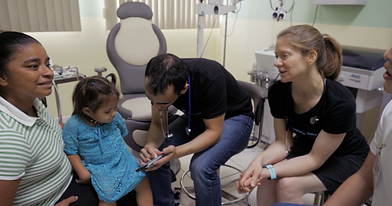
OURIMPACT
AIRWAY RECONSTRUCTION
Airway Reconstruction is a surgical procedure designed to establish a permanent, stable airway for your child to breathe, ideally without the need for a Tracheostomy. When it is determined that there is a narrowing of a child's airway, reconstruction of the Trachea (windpipe) and Larynx (voice box) is often medically necessary.
Narrowing of the airway may occur for a variety of reasons. A child may have been born with a narrow airway (congenial), requiring prolonged intubation following birth or suffered trauma.
If a child has previously had a Tracheostomy, reconstruction of the airway often results in being able to remove the tracheostomy tube.
Pediatric airway reconstruction may also be useful for children born with narrow airways that don’t have a tracheostomy but suffer from recurrent croup episodes or other conditions.
When the narrowing is just below the vocal cords, we call this Subglottic Stenosis
When the airway narrowing is lower down in the trachea, we call this Tracheal Stenosis
There are two different surgical approaches that may be used to treat Subglottic Stenosis:
-
Laryngotracheal Reconstruction: Aims to make the airway bigger
-
Cricotracheal Resection: Designed to remove the scarred airway and bring the sections just above and below the scarred area together

The goal of pediatric Airway Reconstruction surgery is for the child to be able to breathe normally on his or her own.
WHAT IS SUBGLOTTIC STENOSIS?
Subglottic Stenosis ("SGS") is a condition in which a child’s airway is obstructed due to narrowing of the airway or from scarring just below the vocal cords. SGS may be congenital (present at birth) if airway cartilage does not form properly before birth or may be acquired after periods of intubation or ventilation.
This narrowing can also occur lower down in the airway, which is known as Tracheal Stenosis. The scar typically develops early in childhood, often because the child was born premature and required a breathing tube as the lungs developed.
Diagnosis
The best way to diagnose a Stenosis is through an Endoscopy, a procedure in which a small telescope is passed into the airway while the patient is asleep. In some cases, an Imaging Study, such as a CT scan, may be performed if the Stenosis is so narrow that a telescope cannot be passed through it.
Symptoms
Airway Stenosis causes breathing difficulties for children. These difficulties can be mild or severe -- the narrower the airway, the more difficulty your child might experience when breathing
TREATMENT
Significant Stenosis may require placement of a tracheostomy tube to bypass the narrow part of the airway. The tracheostomy is generally placed to allow the child to breathe, feed, and grow until the child becomes healthy and stable enough for further treatment. Pediatric Airway Reconstruction in the form of either Laryngotracheal Reconstruction or Cricotracheal Resection is designed to rebuild the airway and to allow the tracheostomy to be removed. For a child without major heart, lung, or other medical issues, airway reconstruction surgery has an approximately 90 to 95 percent success rate for tracheostomy removal.

current ongoing clinical research
We are actively researching lower subglottal collapse and upper suprastomal tracheal collapse in children to identify the role of less invasive bioresorbable plate placement. If you are interested in obtaining more information regarding your child, please e-mail Dr. Christopher J. Hartnick, M.D. at:
TRACHEOSTOMY
A tracheostomy is a surgically created opening through the neck and into the windpipe that provides a passage for air when the typical route is blocked. It may be used temporarily or for long-term management of airway obstruction that can be caused by a variety of conditions, including:
-
Tumors (abnormal growths) in the larynx or trachea
-
Subglottic Stenosis (narrowing of airway below the vocal folds and above the trachea)
-
Tracheomalacia (softening of tissue of the trachea)
-
Laryngomalacia (softening of tissue of the larynx)
-
Vocal cord paralysis (inability of vocal fold movement)
-
Hemangioma (a vascular malformation in the larynx or trachea)
-
Choanal atresia (narrowing or blockage of nasal passage)
-
Complete tracheal ring (a defect in the cartilage rings that causes narrowing of tracheal passage)


